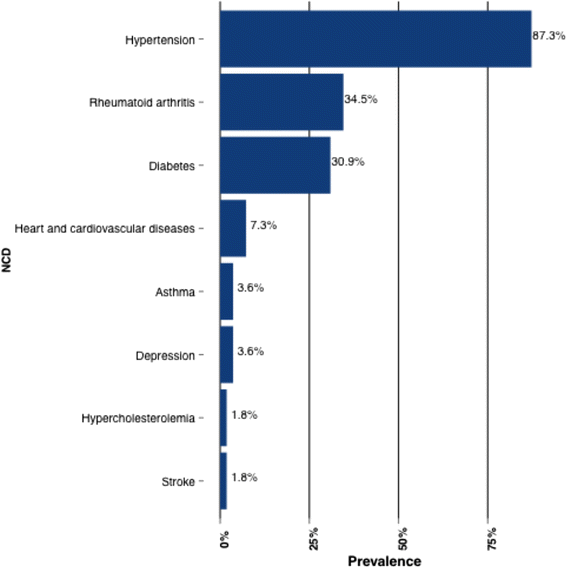Health-seeking behaviours of older black women living with non-communicable diseases in an urban township in South Africa
- PMID: 27776505
- PMCID: PMC5078908
- DOI: 10.1186/s12906-016-1378-4
Health-seeking behaviours of older black women living with non-communicable diseases in an urban township in South Africa
Abstract
Background: Various studies have shown that non-communicable diseases (NCDs) especially diabetes and hypertension are prevalent among older women living in South African urban areas, placing a heavy burden on the healthcare system. This study aimed to understand the health-seeking behaviour, healthcare practices and prevalence of traditional herbal medicine (THM) use among older women self-reporting NCDs from the Prospective Urban Rural Epidemiology study (PURE).
Method: A homogenous purposive sampling of PURE participants was used to recruit women who were 50 years or older (n = 250). Descriptive statistics were used to examine the number of NCDs reported by the study sample, health seeking behaviour and practices as well as THM use. Logistic regression was also employed to investigate possible associations between reported conditions and THM use or medical pluralism.
Results: Within the study sample, 72 % self-reported an NCD. Of those with self-reported NCDs, 46 % had one, and 54 % had two or more NCDs. Those with NCDs usually visited public clinics (80 %), relied on doctors (90 %) and nurses (85 %) for health information, and mostly used conventional medicine (CM) to manage high blood pressure (81 %). About 30 % of those with NCDs indicated using THM, of whom 29 (53 %) reported practicing medical pluralism. Participants with dental problems (OR: 3.24, 95 % CI: 1.30-8.20), headaches (OR: 2.42, 95 % CI: 1.24-4.94), heart burn (OR: 2.30, 95 % CI: 1.18-4.48) and severe tiredness (OR: 2.05, 95 % CI: 1.08-3.99) were more likely to use THM. Anxiety and allergies increased the likelihood to practise medical pluralism by five and 20 times, respectively.
Conclusion: Self-reported NCD with co-morbidities was prevalent among the participants in the study. Most of the study participants utilized state-owned clinics and hospitals for the management of their chronic conditions. THM use was not very common. However, among those who used THM, medical pluralism was prevalent. Family history was the most common reason for THM use, with many THM patrons utilizing these for treatment of a health condition. Older black women with anxiety and allergies were more likely to practise medical pluralism.
Keywords: Medical pluralism; Non-communicable diseases; Older women; Traditional herbal medicine.
Figures
Similar articles
-
The prevalence of traditional herbal medicine use among hypertensives living in South African communities.BMC Complement Altern Med. 2013 Feb 18;13:38. doi: 10.1186/1472-6882-13-38. BMC Complement Altern Med. 2013. PMID: 23414344 Free PMC article.
-
Perspectives on healthcare, chronic non-communicable disease, and healthworlds in an urban and rural setting.Glob Health Action. 2014 Sep 24;7:25317. doi: 10.3402/gha.v7.25317. eCollection 2014. Glob Health Action. 2014. PMID: 25261700 Free PMC article.
-
Self-reported prevalence of chronic non-communicable diseases and associated factors among older adults in South Africa.Glob Health Action. 2013 Sep 19;6:20936. doi: 10.3402/gha.v6i0.20936. Glob Health Action. 2013. PMID: 24054088 Free PMC article.
-
Where does the black population of South Africa stand on the nutrition transition?Public Health Nutr. 2002 Feb;5(1A):157-62. doi: 10.1079/PHN2001288. Public Health Nutr. 2002. PMID: 12027279 Review.
-
Noncommunicable diseases among urban refugees and asylum-seekers in developing countries: a neglected health care need.Global Health. 2014 Apr 3;10:24. doi: 10.1186/1744-8603-10-24. Global Health. 2014. PMID: 24708876 Free PMC article. Review.
Cited by
-
Prevalence and correlates of chronic diseases in an elderly population: A community-based survey in Haikou.PLoS One. 2018 Jun 14;13(6):e0199006. doi: 10.1371/journal.pone.0199006. eCollection 2018. PLoS One. 2018. PMID: 29902222 Free PMC article.
-
"It's like it's the old boys club"-the age-related experiences of diverse older women living with HIV: A scoping review and consultative exercise.HIV Med. 2025 Apr;26(4):546-568. doi: 10.1111/hiv.13751. Epub 2024 Dec 12. HIV Med. 2025. PMID: 39667759 Free PMC article.
-
Hypertension in older adults in Africa: A systematic review and meta-analysis.PLoS One. 2019 Apr 5;14(4):e0214934. doi: 10.1371/journal.pone.0214934. eCollection 2019. PLoS One. 2019. PMID: 30951534 Free PMC article.
-
Predictors of Medication-Related Emergency Department Admissions Among Patients with Cardiovascular Diseases at Mbarara Regional Referral Hospital, South-Western Uganda.Open Access Emerg Med. 2021 Jun 29;13:279-290. doi: 10.2147/OAEM.S309508. eCollection 2021. Open Access Emerg Med. 2021. PMID: 34234583 Free PMC article.
-
Potential factors that influence usage of complementary and alternative medicine worldwide: a systematic review.BMC Complement Med Ther. 2020 Nov 23;20(1):363. doi: 10.1186/s12906-020-03157-2. BMC Complement Med Ther. 2020. PMID: 33228697 Free PMC article.
References
-
- World Health Organization . Mortality and burden of disease estimates for WHO Member States in 2004. Geneva: World Health Organization; 2009.
-
- Williams R, Krakauer R, et al. The challenge of non-communicable diseases and geriatric conditions. In: Beard J, Biggs S, Bloom D, Fried L, Hogan P, Kalache A, Olshansky SJ, et al., editors. Global population ageing: peril or promise? Geneva, Switzerland world economic forum (Global Agenda Council (GAC) on ageing society) 2011. pp. 78–81.
-
- The NCD Alliance. Non-communicable Diseases: A priority for Women’s health and development. http://ncdalliance.org/sites/default/files/resource_files/Non%20Communic.... Accessed 14 Jul 2015.
-
- He W, Muenchrath M, Kowal P. Shades of gray: a cross-country study of health and well-being of the older populations in SAGE countries, 2007–2010. U.S. census bureau, U.S. Washington, DC: GPO; 2012.
MeSH terms
LinkOut - more resources
Full Text Sources
Other Literature Sources
Medical


